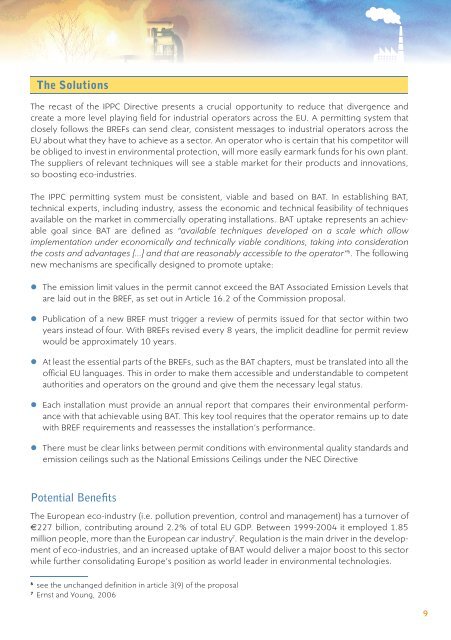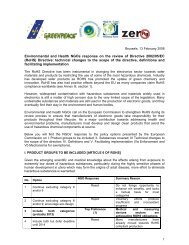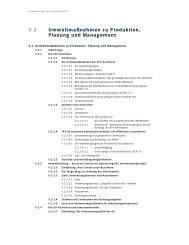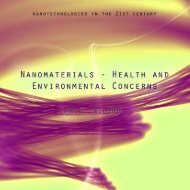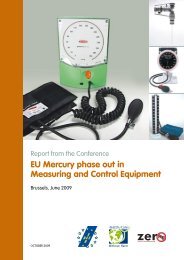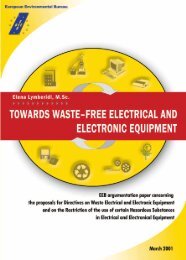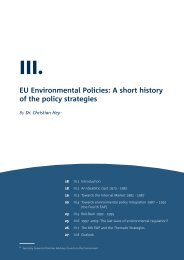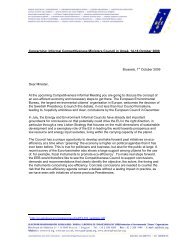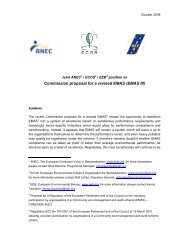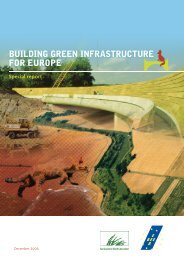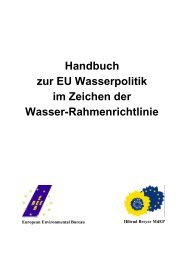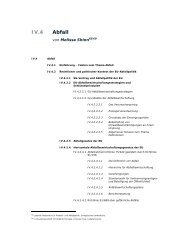A push for cleaner industrial production - EEB
A push for cleaner industrial production - EEB
A push for cleaner industrial production - EEB
You also want an ePaper? Increase the reach of your titles
YUMPU automatically turns print PDFs into web optimized ePapers that Google loves.
The Solutions<br />
The recast of the IPPC Directive presents a crucial opportunity to reduce that divergence and<br />
create a more level playing field <strong>for</strong> <strong>industrial</strong> operators across the EU. A permitting system that<br />
closely follows the BREFs can send clear, consistent messages to <strong>industrial</strong> operators across the<br />
EU about what they have to achieve as a sector. An operator who is certain that his competitor will<br />
be obliged to invest in environmental protection, will more easily earmark funds <strong>for</strong> his own plant.<br />
The suppliers of relevant techniques will see a stable market <strong>for</strong> their products and innovations,<br />
so boosting eco-industries.<br />
The IPPC permitting system must be consistent, viable and based on BAT. In establishing BAT,<br />
technical experts, including industry, assess the economic and technical feasibility of techniques<br />
available on the market in commercially operating installations. BAT uptake represents an achievable<br />
goal since BAT are defined as “available techniques developed on a scale which allow<br />
implementation under economically and technically viable conditions, taking into consideration<br />
the costs and advantages [...] and that are reasonably accessible to the operator” 6 . The following<br />
new mechanisms are specifically designed to promote uptake:<br />
• The emission limit values in the permit cannot exceed the BAT Associated Emission Levels that<br />
are laid out in the BREF, as set out in Article 16.2 of the Commission proposal.<br />
• Publication of a new BREF must trigger a review of permits issued <strong>for</strong> that sector within two<br />
years instead of four. With BREFs revised every 8 years, the implicit deadline <strong>for</strong> permit review<br />
would be approximately 10 years.<br />
• At least the essential parts of the BREFs, such as the BAT chapters, must be translated into all the<br />
official EU languages. This in order to make them accessible and understandable to competent<br />
authorities and operators on the ground and give them the necessary legal status.<br />
• Each installation must provide an annual report that compares their environmental per<strong>for</strong>mance<br />
with that achievable using BAT. This key tool requires that the operator remains up to date<br />
with BREF requirements and reassesses the installation’s per<strong>for</strong>mance.<br />
• There must be clear links between permit conditions with environmental quality standards and<br />
emission ceilings such as the National Emissions Ceilings under the NEC Directive<br />
Potential Benefits<br />
The European eco-industry (i.e. pollution prevention, control and management) has a turnover of<br />
€227 billion, contributing around 2.2% of total EU GDP. Between 1999-2004 it employed 1.85<br />
million people, more than the European car industry 7 . Regulation is the main driver in the development<br />
of eco-industries, and an increased uptake of BAT would deliver a major boost to this sector<br />
while further consolidating Europe’s position as world leader in environmental technologies.<br />
6<br />
see the unchanged definition in article 3(9) of the proposal<br />
7<br />
Ernst and Young, 2006<br />
9


